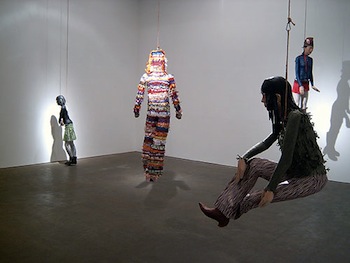Press Release
Leo Koenig Inc. is pleased to present recent sculptures by Los Angeles based artist, Meg Cranston. A conceptualist, Cranston consistently works in a variety of media, including performance, photography, painting, sculpture and drawing. Within all of these, she creates works that appear deceptively simple while resonating with gradations of complexity that transcend the confines of their form.
For this exhibition, Cranston has created a group of life-size piñatas depicting the artist herself. Molded and finished in brightly colored paper, each of the piñatas strikes a pose characteristic of the artist. The effigies are based on the visual and iconographic traditions associated with piñatas, which have a fascinating yet little-known history. Literally translated from Latin “piñata” means “Pine of Attis”—a conflation of the words for pine (pino) and ‘ata or Attis, a god of vegetation once worshiped in Western Asia. In ancient times, members of Attis’ cult hung offerings from pine-trees and then beat them as offerings to the god. With their migration from East to West, the function and form of piñatas changed evolving from paper vessels symbolizing Spring-time fertility in ancient China to Catholic metaphors for the seven deadly sins, and, most recently, as secular party favors.
Playing upon the role of the piñata as a sacrificial object, she depicts herself as a martyr/totem, but she does not see her sculptures in a wholly negative light. Cranston states: “I suppose there is an aspect of masochism in the work, though in my view the masochist is a sort of grandiose daredevil who endures humiliation to prove they are invincible.”
Cranston’s longstanding interests in anthropology (a field in which she received her Bachelor’s Degree) and cultural history have always shaped her approach to making art in both material and conceptual ways. In fact, Cranston calls her sculptures “Magical Death” after a 1973 ethnographic film by Napoleon Chagnon and Timothy Asch, which vividly depicted the shamanic ceremonies of the Yanomamo Indians. In the film the Yanomano symbolically murder or “inflict” a “magical death” upon the children of enemy tribes to insure their own survival.
Since 1986, Meg Cranston has participated in group and major solo exhibitions in America, Europe, and Australia, including the Venice Biennale (1993). In 1994, she received a fellowship in sculpture and installation from the John Simon Guggenheim Memorial Foundation. Cranston presently lives and works in Venice, California, and is a Professor at Otis College of Art and Design in Los Angeles.
